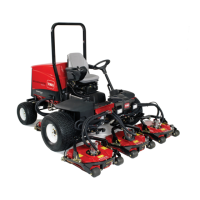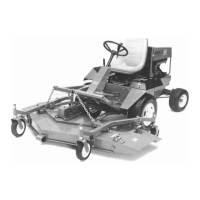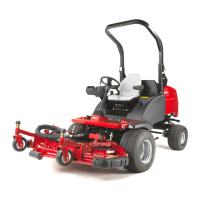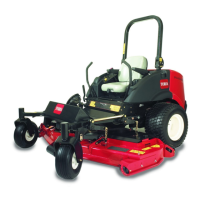Groundsmaster 4300--D Hydraulic SystemPage 4 -- 11
Traction Circuit
The hydraulic traction circuit consists of a variable dis-
placementpistonpump(P5)connectedinaclosedloop,
parallel circuit to four (4) orbital roller vane wheel mo-
tors. The traction pump input shaft is rotated by a drive
shaft that is driven from the engine flywheel.
Forward traction circuit pressure can be measured at a
test port located in the hydraulic tube that connects the
front wheel motors. Reverse traction circuit pressure
can be measured at test ports in the AWD control man-
ifold.
Forward Direction (Fig. 10)
Pushing thetop of the traction pedalangles the traction
pump swash plate to create a flow of oil. This oil flow is
directed to the wheel motors via hydraulic hoses and
tubes to drive the wheels in the forward direction. Trac-
tion pump flowis directed to thefront wheel motors and
thentotheoppositerearwheelmotorstomaximizetrac-
tion. To reduce tire scuffing when turning, traction sys-
tem pressure is equalized in the AWD control manifold
with an orifice and a bi--directional relief valve. Check
valvesintheAWDmanifold allowtherearwheelmotors
toover--runduringtightturns.Forwardtractionpressure
is limited to 3625 PSI (250 bar) by the forward traction
relief valve (R3) located in the traction pump.
Oilflowingfromthewheelmotorsreturns tothevariable
displacement pump and is continuously pumped
through the traction circuit as long as the traction pedal
is pushed.
Theangleoftheswashplatedeterminespumpflowand
ultimatelytractionspeed.Whenthe tractionpedal isde-
pressedasmallamount,asmallswashplaterotationre-
sultsinlowpumpoutputandlowertractions peed.When
the traction pedal is depressed fully, the pump swash
platerotatesfullyto providemaximumpumpoutputand
traction speed.
Gearpumpsection(P3)suppliesoilflowforthesteering
circuitand alsoprovides a constantsupply ofc harge oil
to the closed loop traction circuit. This charge oil pro-
videslubricationfortractioncircuitcomponentsandalso
replenishes traction circuit oil that is lost due to internal
leakage in the traction circuit.
Gear pump section (P3) takes its suction from the hy-
draulicreservoir.Chargepumpflowisdirectedtothelow
pressure sideof the closedloop traction circuit.Charge
relief valve (R5) located in the traction pump limits the
charge relief pressure to 200 PSI (14 bar).
The piston pump is equipped with a case drain to allow
internal leakage to be removed from the pump. The
case drain is connected to the gear pump inlet.
The piston pump (P5) includes a flushing valve that
bleeds off a small amount of hydraulic fluid for cooling
oftheclosedlooptractioncircuit.Thechargesystemre-
plenishes oil that is bled from the traction circuit by the
flushing valve.
Reverse Direction
The traction circuit operates essentially the same in re-
verse as it does in the forward direction. However, the
flow through the circuit is reversed. Pushing thebottom
of the traction pedal rotates the traction pump s wash
plate to create a flow of oil. This oil is directed to the
wheel motors to drive the wheels in the reverse direc-
tion. Reverse traction pressure is limited to 3625 PSI
(250bar)bythereversetractionreliefvalve(R4)located
in the traction pump.
Oil flowingfrom thewheelmotors returns tothe traction
pump and is continuously pumped through the closed
loop traction circuit as long as the traction pedal is
pushed.
The chargecircuit and flushing valvefunction the same
in reverse as they do in the forward direction.
Hydraulic
System

